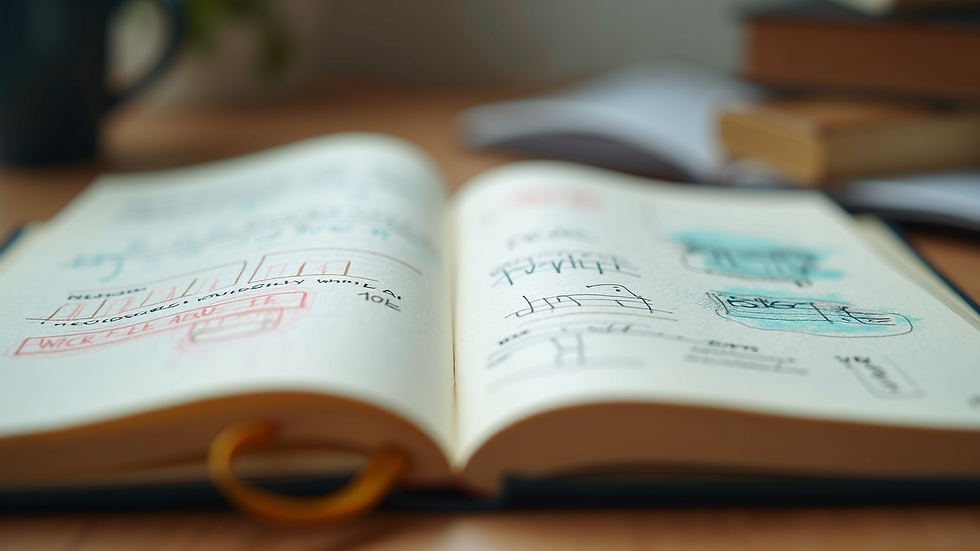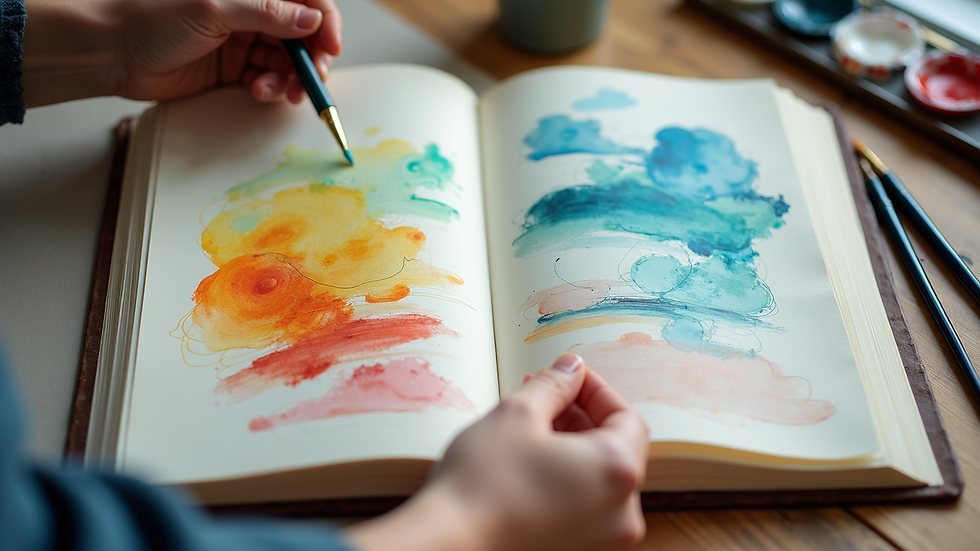Creative Ways to Use Notebooks and Journals
- mandgpublishing
- Aug 10
- 5 min read
Have you ever wondered how many ways you can use a simple notebook or journal? I have, and the answer surprised me. These humble books are more than just blank pages. They are tools for creativity, organization, reflection, and so much more. Whether you’re a professional, a student, an artist, a musician, or a parent, there’s a creative use for journals that can fit your lifestyle perfectly.
If you’re curious about how to make the most out of your notebooks and journals, keep reading. I’ll share practical ideas, examples, and tips that you can start using today.
Creative Uses for Journals That You Might Not Have Tried
Journals are often seen as places to write daily thoughts or keep a diary. But they can be so much more. Here are some creative ways to use journals that go beyond the usual:
Goal Setting and Tracking
Use your journal to set clear goals and track your progress. Break big goals into smaller steps and check them off as you go. This keeps you motivated and focused.
Brainstorming and Idea Dumping
Whenever an idea strikes, jot it down immediately. Your journal becomes a treasure chest of inspiration you can revisit anytime.
Meal Planning and Recipe Collection
Plan your weekly meals or collect your favorite recipes. This is especially handy for busy parents or anyone who loves cooking.
Gratitude Journal
Write down things you’re grateful for each day. It’s a simple habit that can boost your mood and outlook.
Travel Journal
Document your trips with notes, sketches, and tickets. It’s a wonderful way to preserve memories.
These are just a few examples. The beauty of journals is that they adapt to your needs and interests.

What’s the Difference Between a Notebook and a Journal?
You might wonder if there’s a real difference between a notebook and a journal. I used to think they were the same, but here’s what I found:
Notebook
Usually, a notebook is a blank or lined book used for taking notes, writing lists, or jotting down information. It’s often more functional and less personal.
Journal
A journal tends to be more personal and reflective. It’s a place to record thoughts, feelings, experiences, and ideas. Journals often encourage creativity and self-expression.
Of course, the lines can blur. Some notebooks are designed with prompts or sections that make them feel like journals. And some journals are simple and straightforward like notebooks.
Choosing between the two depends on what you want to do. If you want to organize information, a notebook might be best. If you want to explore your thoughts or creativity, a journal is the way to go.
How to Use Notebooks and Journals for Work and Study
If you’re juggling work or school, notebooks and journals can be your secret weapon. Here’s how I use them to stay on top of things:
Meeting Notes and Action Items
Keep a dedicated notebook for meetings. Write down key points and action items. This helps you remember tasks and follow up efficiently.
Project Planning
Use a journal to map out projects. Break down tasks, set deadlines, and track progress. Visualizing your work makes it easier to manage.
Study Notes and Summaries
Summarize lessons or readings in your journal. Writing things down helps with retention and understanding.
Creative Problem Solving
When stuck on a problem, sketch ideas or write out possible solutions in your journal. Sometimes, seeing things on paper sparks new insights.
Daily To-Do Lists
Start your day by listing tasks in your notebook. Crossing off completed items feels rewarding and keeps you productive.
Using journals and notebooks in these ways can reduce stress and increase efficiency. Plus, it’s satisfying to see your progress in black and white.

Artistic and Musical Uses for Journals
If you’re an artist or musician, journals can be your creative playground. Here’s how I’ve seen them used:
Sketchbooks and Doodle Journals
Fill pages with sketches, doodles, and visual ideas. It’s a great way to practice and develop your style.
Songwriting and Lyrics
Write down lyrics, chord progressions, or song ideas. Having a dedicated journal keeps your creative work in one place.
Mood Boards and Inspiration Collages
Paste photos, fabric swatches, or color samples. This helps you visualize themes and moods for projects.
Practice Logs
Track your practice sessions, note improvements, and set goals. This keeps you motivated and focused.
Creative Writing
Use your journal for poetry, short stories, or free writing. It’s a safe space to experiment without pressure.
These creative uses turn journals into more than just books - they become companions on your artistic journey.

Journals for Parents: Organizing Family Life and Memories
Parents have a lot on their plates, and journals can help keep things running smoothly. Here are some ways to use journals for family life:
Family Schedules and Calendars
Keep track of appointments, school events, and activities. A journal can be your family’s command center.
Meal Planning and Grocery Lists
Plan meals and write grocery lists to save time and reduce stress.
Memory Books
Record milestones, funny moments, and special events. These journals become treasured keepsakes.
Behavior and Health Logs
Track your child’s behavior, moods, or health symptoms. This can be useful for doctor visits or school meetings.
Creative Activities and Crafts
Plan and record craft ideas or family projects. It’s a fun way to stay organized and inspired.
Using journals in these ways helps parents feel more in control and connected to their family’s daily life.
Why You Should Start Your Own Journal Today
If you haven’t started a journal yet, what’s stopping you? The benefits are clear:
Boosts Creativity
Journals encourage you to explore ideas and express yourself.
Improves Organization
Keeping notes, plans, and lists in one place saves time and reduces stress.
Supports Mental Health
Writing about your thoughts and feelings can be therapeutic.
Preserves Memories
Journals capture moments and experiences you’ll want to remember.
Enhances Learning
Writing helps you process and retain information better.
Starting is easy. Choose a journal that fits your style and purpose. It could be a simple lined notebook or a beautifully designed journal from a trusted source like notebooks and journals. Set aside a few minutes each day or week to write, draw, or plan. You’ll be surprised how quickly it becomes a rewarding habit.
Journals and notebooks are more than just paper and covers. They are tools that can transform how you think, create, and organize your life. Whether you use them for work, study, art, music, or family, the possibilities are endless. So grab your favorite journal today and start exploring your own creative uses for journals. You might just discover a new favorite way to express yourself and stay on track.
Happy journaling!







These ideas make me want to dust off my old journal and give it new life! I especially liked the tip about using it for brainstorming and planning. Thanks for sharing! I once started a notebook just for research ideas, and later used parts of it when writing up for a paper published in Scopus, small notes can turn into big contributions.